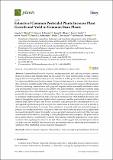| dc.description.abstract | Common bean () is an important food and cash crop in many countries. Bean crop yields in sub-Saharan Africa are on average 50% lower than the global average, which is largely due to severe problems with pests and diseases as well as poor soil fertility exacerbated by low-input smallholder production systems. Recent on-farm research in eastern Africa has shown that commonly available plants with pesticidal properties can successfully manage arthropod pests. However, reducing common bean yield gaps still requires further sustainable solutions to other crop provisioning services such as soil fertility and plant nutrition. Smallholder farmers using pesticidal plants have claimed that the application of pesticidal plant extracts boosts plant growth, potentially through working as a foliar fertiliser. Thus, the aims of the research presented here were to determine whether plant growth and yield could be enhanced and which metabolic processes were induced through the application of plant extracts commonly used for pest control in eastern Africa. Extracts from and were prepared at a concentration of 10% and applied to potted bean plants in a pest-free screen house as foliar sprays as well as directly to the soil around bean plants to evaluate their contribution to growth, yield and potential changes in primary or secondary metabolites. Outcomes of this study showed that the plant extracts significantly increased chlorophyll content, the number of pods per plant and overall seed yield. Other increases in metabolites were observed, including of rutin, phenylalanine and tryptophan. The plant extracts had a similar effect to a commercially available foliar fertiliser whilst the application as a foliar spray was better than applying the extract to the soil. These results suggest that pesticidal plant extracts can help overcome multiple limitations in crop provisioning services, enhancing plant nutrition in addition to their established uses for crop pest management. | en_US |

